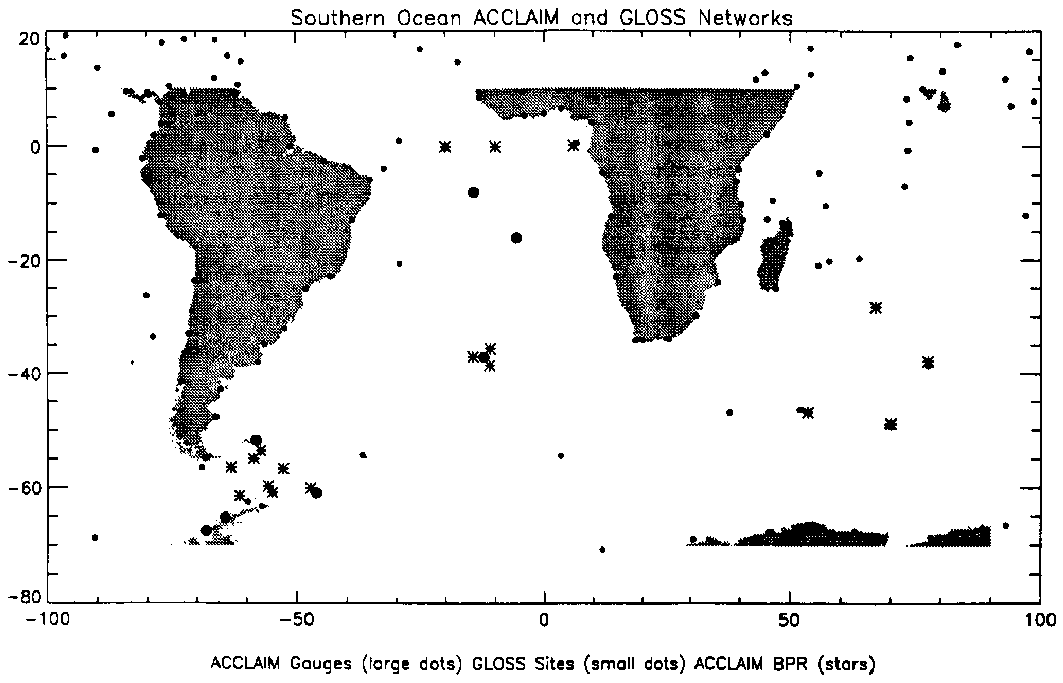
P. L. Woodworth and J. M. Vassie Froudman Oceanographic
Readers of Afro-America GLOSS News will no doubt be interested in the status of sea level monitoring at a number of islands in the South Atlantic.
The ACCLAIM (Antarctic Circumpolar Current Levels by Altimetry and Island Measurements) programme in the South Atlantic and Southern Oceans consists of measurements from coastal tide gauges and bottom pressure stations, together with an ongoing research programme in satellite altimetry. ACCLAIM is the Proudman Oceanographic Laboratory's main contribution to the World Ocean Circulation Experiment (WOCE), in particular to WOCE Core 2 (Southern Ocean). One of its main objectives is the study of variations of the Antarctic Circumpolar Current, in addition to providing data for GLOSS. ACCLAIM is managed within the Global Sea Level Change (GSLC) group at POL led by Ian Vassie.
The history of the development of ACCLAIM is described in the report by Spencer et al. (1993):

In that report it will be seen that, in Phase 1 of ACCLAIM from 1983, measurements at coastal tide gauge sites took the form of sub-surface pressure (SSP) measurements (units of pressure e.g. mbar) rather than sea leve1 (units of length e.g. centimetres). SSP is here defined as the total, measured pressure recorded by a sub-surface pressure transducer, a measurement which induces the pressure load from the atmosphere as well as from the water column. Of course, it is absolutely essentia1 that any user of ACCLAIM data releases which data type (either SSP or sea level) is being analysed.
From around early 1993, the gauges at many of the sites were replaced
by Phase 2 ACCLAM "B gauges" which record SSP, air pressure and sea level
as described in:
As of October 1994, Phase 2 gauges are operational at Ascension, St.
Helena, Port Stanley and Rothera (Antarctic Peninsula), while phase 1 gauges
remain at Tristan da Cunha and Signy. When harbour works are completed
at Tristan, then the gauge there will be upgraded. However the gauge at
Signy will remain a Phase 1 type for the foreseeable future. A conventional
stilling well gauge continues to be operated at Faraday (Antarctic Peninsula)
in a joint programme with the British Antarctic Survey (BAS). The Figure
1 shows the locations of ACC sites and of other GLOSS-related stations
in the region.
The Phase 1 coastal SSP data were acquired in different ways (e.g. with a diver-replaced Aanderaa pressure gauge at Ascension, or with a Digiquartz in the sea sensor at St. Helena, see Spencer et al. 1993 for details) and with different pressure integration periods (e.g. quarter hour, half hour, one hour). For WOCE purposes, the original data have generally been filtered to give one hour sampling. However, common to all records is an uncertainly connected with potential offset biases and drifts inherent in all pressure sensors At some sites (e.g. St. Helena) extensive tide pole data are also available and biases and long term drifts in the sensor data may eventually be rectified (this is under study at present). However, the drifts in general mean that in most cases the records should not be used, with out further careful attention in particular studies, for the study of timescales seasonal or longer.
The Phase 2 coastal sea level data have precise datum control (see Woodworth et al. 1994 for details) and can certainly be used for long term studies. These data have also been contributed to the Permanent Service for Mean Sea Level (PSMSL) and to GLOSS.
Some of the Phase 1 data and all the Phase 2 coastal data will also contain ancillary information on air pressures and sea temperatures from ACCLAIM sensors. Several of these records contain large gaps. However, the GSLC group at POL has collected extensive sets of such ancillary data from meteorological agencies for its own analysis purposes, and should be able to provide further advice to any user of ACCLAIM data.
Scotia Sea - Drake Passage area of the Southern Ocean as part of WOCE Core 2. Tidal constituent from these recorders have been contributed to the IAPSO Pelagic Constants data base maintained by the PSMSL at Bidston on behalf of IAPSO.
At the time of writing, an Internet ftp facility is being established for ACCLAIM data by the British Oceanographic Data Centre (BODC) and the data wi11 be available freely to any interested scientist. Further information may be obtained from Dr L. J. Rickards (BODC) or from the authors of this note.
References
Spencer, R., Foden, P.R., McGarry, C., Harrison, a.j., Vassie, J.M., Baker, T.F., Smithson, M.j., Harangozo, S.A. and Woodworth, P.L. 1993. The ACCLAIM programme in the South Atlantic and Southern Oceans. International Hydrographic Review, 70, 7-21.
Woodworth, P.L., Vassie, J.M., Spencer, R. and Smith, D.E. 1994. Precise
datum control for pressure tide gauges. To be published in Marine Geodesy.